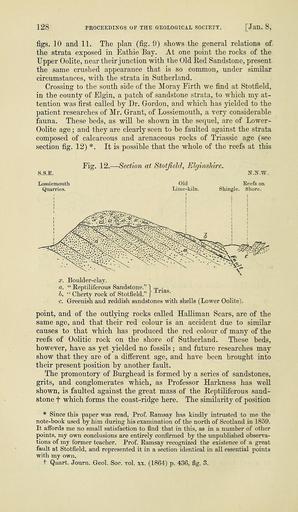MAKE A MEME
View Large Image

| View Original: | The_Quarterly_journal_of_the_Geological_Society_of_London_(13368840645).jpg (1853x3186) | |||
| Download: | Original | Medium | Small | Thumb |
| Courtesy of: | commons.wikimedia.org | More Like This | ||
| Keywords: The Quarterly journal of the Geological Society of London (13368840645).jpg 128 <br> PKOCEEDINGS OF THE GEOLOGICAL SOCIETY <br> Jan 8 <br> figs 10 and 11 The plan fig 9 shows the general relations of <br> the strata exposed in Eathie Bay At one point the rocks of the <br> Upper Oolite near their junction with the Old Red Sandstone present <br> the same crushed appearance that is so common under similar <br> circumstances with the strata in Sutherland <br> Crossing to the south side of the Moray Firth we find at Stotfield <br> in the county of Elgin a patch of sandstone strata to which my at- <br> tention was first called by Dr Gordon and which has yielded to the <br> patient researches of Mr Grant of Lossiemouth a very considerable <br> fauna These beds as will be shown in the sequel are of Lower- <br> Oolite age ; and they are clearly seen to be faulted against the strata <br> composed of calcareous and arenaceous rocks of Triassic age see <br> section fig 12 It is possible that the whole of the reefs at this <br> S S E <br> Fig 12 ” Section at Stotfield Elginshire <br> N U W <br> Eeefs on <br> Shingle Shore <br> x Boulder-clay <br> a Reptiliferous Sandstone <br> b Cherty rock of Stotfield <br> c Greenish and reddish sandstones with shells Lower Oolite <br> Trias <br> point and of the outlying rocks called Halliman Scars are of the <br> same age and that their red colour is an accident due to similar <br> causes to that which has produced the red colour of many of the <br> reefs of Oolitic rock on the shore of Sutherland These beds <br> however have as yet yielded no fossils ; and future researches may <br> show that they are of a different age and have been brought into <br> their present position by another fault <br> The promontory of Burghead is formed by a series of sandstones <br> grits and conglomerates which as Professor Harkness has well <br> shown is faulted against the great mass of the Reptiliferous sand- <br> stone f which forms the coast-ridge here The similarity of position <br> Since this paper was read Prof Ramsay has kindly intrusted to me the <br> note-hook used by him during his examination of the north of Scotland in 1859 <br> It affords me no small satisfaction to find that in this as in a number of other <br> points my own conclusions are entirely confirmed by the unpublished observa- <br> tions of my former teacher Prof Ramsay recognized the existence of a great <br> fault at Stotfield and represented it in a section identical in all essential points <br> with my own <br> t Quart Journ Geol Soc vol xx 1864 p 436 fig 3 39051032 120601 51125 Page 128 Text v 29 http //www biodiversitylibrary org/page/39051032 1873 Geological Society of London Biodiversity Heritage Library The Quarterly journal of the Geological Society of London v 29 1873 Geology Periodicals Smithsonian Libraries bhl page 39051032 dc identifier http //biodiversitylibrary org/page/39051032 smithsonian libraries Information field Flickr posted date ISOdate 2014-03-24 Check categories 2015 August 26 CC-BY-2 0 BioDivLibrary https //flickr com/photos/61021753 N02/13368840645 2015-08-26 10 56 20 cc-by-2 0 PD-old-70-1923 The Quarterly journal of the Geological Society of London 1873 Photos uploaded from Flickr by Fæ using a script | ||||